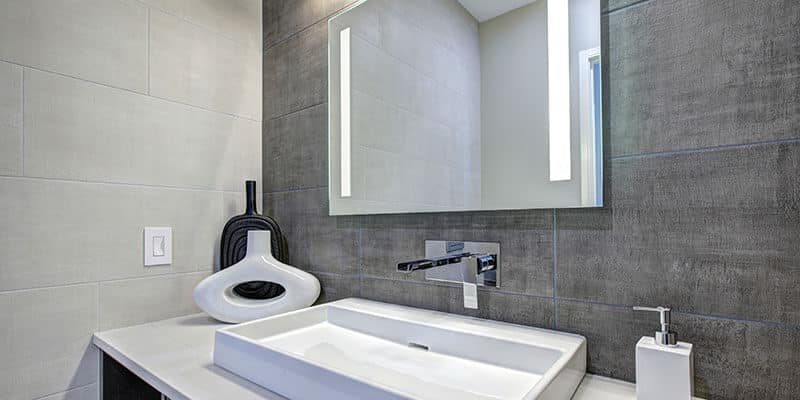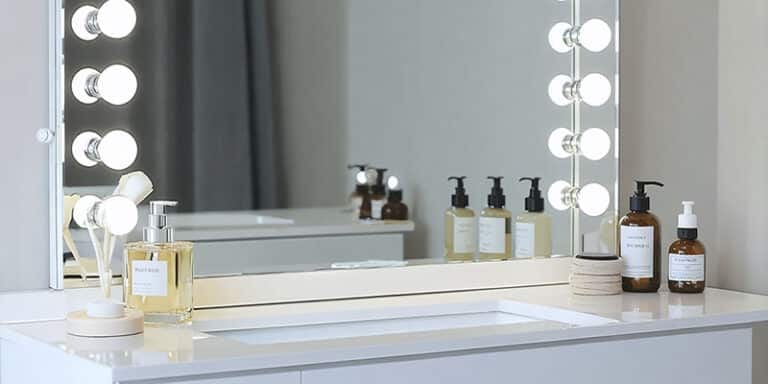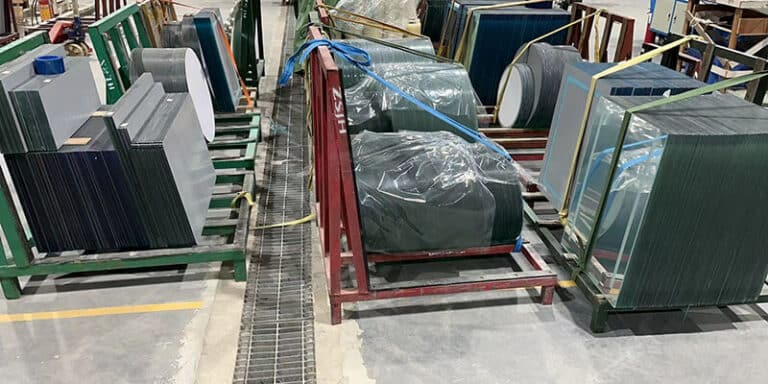Bathroom mirrors are more than just reflective surfaces; they are pivotal elements of bathroom decor and functionality. As you consider revamping your bathroom, the types of bathroom mirrors you choose play a vital role in shaping the space. The right mirror not only facilitates daily grooming routines but can also create the illusion of space, amplify light, and add a touch of elegance to modern bathrooms.
The selection of a bathroom mirror is guided by both aesthetic appeal and practical considerations. From pivot mirrors that adjust for optimal viewing angles to sleek frameless designs for a minimalist look, the wide variety of mirror types offers something for every preference and need. Considering factors such as size, shape, and additional features like integrated lighting or storage can significantly enhance the efficiency of your bathroom.
Key Takeaways
- Selecting the right bathroom mirror impacts both the functionality and style of your space.
- Bathroom mirrors come in various shapes, sizes, and styles, including options with advanced features.
- To optimize your bathroom design, consider mirror size, shape, framing, functionality, and placement.
Why Do You Need a Bathroom Mirror?
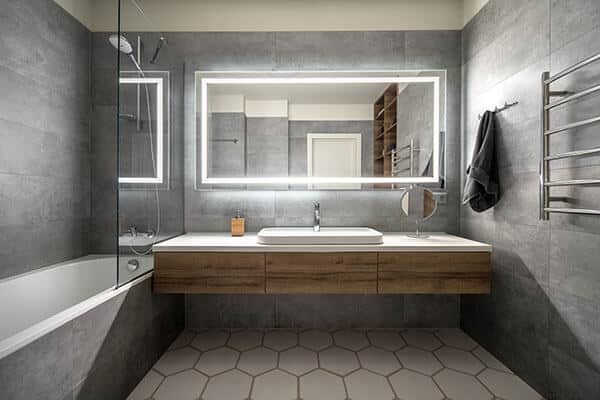
When you think of a functional bathroom, one of the most important components is the bathroom mirror. It serves as a focal point and has significant utility for daily grooming tasks. Whether you’re shaving, applying makeup, or styling your hair, a bathroom mirror is indispensable. It allows you to check your appearance and perform precise grooming with confidence.
Apart from serving personal care needs, a bathroom mirror is also an integral design element that enhances the overall look of your bathroom. Mirrors come in varied shapes, sizes, finishes, and styles that contribute to your room’s design and can reflect your personal taste. Clever placement can reinforce design cohesion.
In modern times, bathroom mirrors usually have LED lighting bars surrounding the mirror, providing direct light on your face. This is highly beneficial when applying makeup as it offers better lighting compared to traditional fixtures that are above the mirror or on the ceiling. Such fixtures can create shadows, which can negatively affect the makeup.
In small bathrooms, mirrors can create an illusion of space, making the room appear larger and providing a better experience.
By choosing color schemes and material of framed mirrors, you can design a consistent theme or add stark contrast. A bathroom mirror is not just a tool but an element that completes your bathroom’s style.
Can You Use A Regular Mirror in the Bathroom?
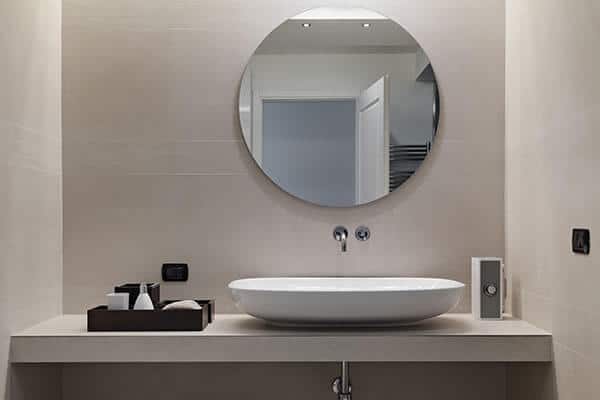
When selecting a mirror for your bathroom, it is crucial to consider the environment it will be in. Bathrooms are high-humidity environments, which can influence both the durability and safety of the product you choose.
Regular Mirrors vs. Bathroom-Specific Mirrors:
- Regular mirrors are typically not designed for high moisture areas. Over time, exposure to steam and humidity can deteriorate their reflective coating and backing material, leading to spots, peeling, or even mold.
- Mirrors made for bathrooms often come with special features, such as copper free layers, moisture-resistant backing or improved sealing ethoxylate resin, that prevent moisture penetration and prolong their life.
Using Regular Mirrors:
- You can use a regular mirror in your bathroom, but it may require more maintenance. Additionally, they might not be as safe if the backing deteriorates and the glass becomes compromised.
- For short-term or less humid rooms, a regular mirror might suffice; however, for long-term use, consider a mirror tailored for bathroom conditions to avoid the risk of damage.
Type of Mirror to Choose:
- Identify mirrors specifically marketed for bathroom use or described as moisture-resistant.
- Opt for a glass that has been treated or tempered for enhanced safety in the event of breakage.
By understanding the unique challenges of a bathroom setting, you can make an informed decision on whether a regular mirror suits your needs or if investing in a bathroom-specific mirror is the wiser choice.
What Is the Ideal Mirror Shape for My Bathroom?
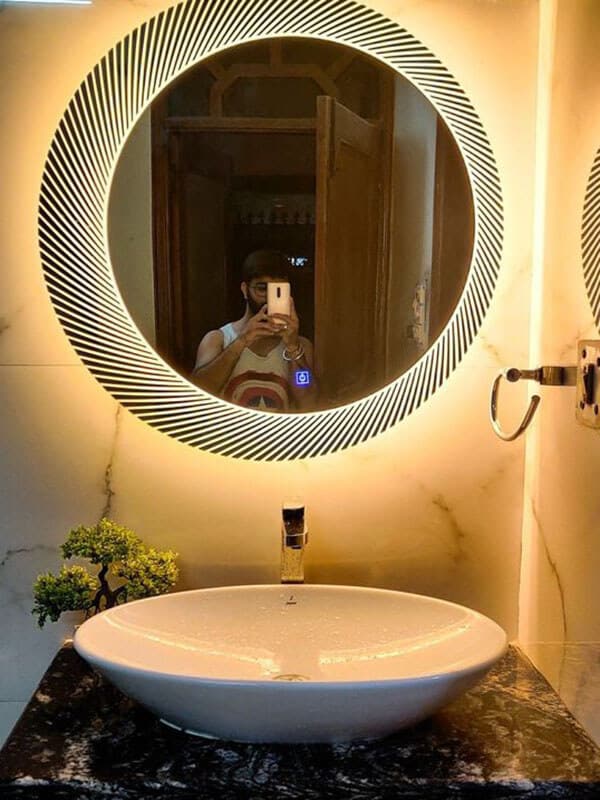
Selecting the appropriate mirror shape for your bathroom can transform the space, adding both function and style. Here’s how to align your choice with your bathroom’s layout, design style, and functional needs.
Rectangular Mirrors: They are a classic choice that complements most design styles. Their horizontal orientation is practical, expanding the sense of space across the wall.
- Frameless Mirrors: A frameless rectangular mirror gives a sleek, modern look, while also making the bathroom appear larger.
- Framed Mirrors: Choosing a frame adds character, with the potential to incorporate materials and colors matching your bathroom’s decor.
Round Mirrors: These are excellent for introducing softness to a bathroom dominated by hard lines and angles. The round shape is effective at breaking up the symmetry and adds an intriguing visual element.
- Use round mirrors to add balance and to serve as a focal point over the vanity.
Oval Mirrors: Combining the elongation of rectangular mirrors with the soft edges of round mirrors, oval mirrors bring a harmonious blend to the space. Oval bathroom mirrors are particularly suited to bathrooms with limited wall space or narrower vanities.
- Oval mirrors can give the illusion of height when placed vertically or create a sense of width when oriented horizontally.
Unique Shapes: For a bathroom that reflects your personal style, consider custom or asymmetrical mirrors. These unique shapes can offer the most flexibility in tailoring to your bathroom’s aesthetic.
- Asymmetrical mirrors can be designed to fit specific spaces, complement other design elements, and serve as a striking decorative feature.
Assessing your bathroom’s size, existing decor, and your personal preferences will guide you in choosing the ideal mirror shape. Whether you opt for a traditional frame or a more modern frameless design, ensure that the mirror functionality meets your daily needs while enhancing the overall style of your space.
What Size Should a Bathroom Mirror Be?
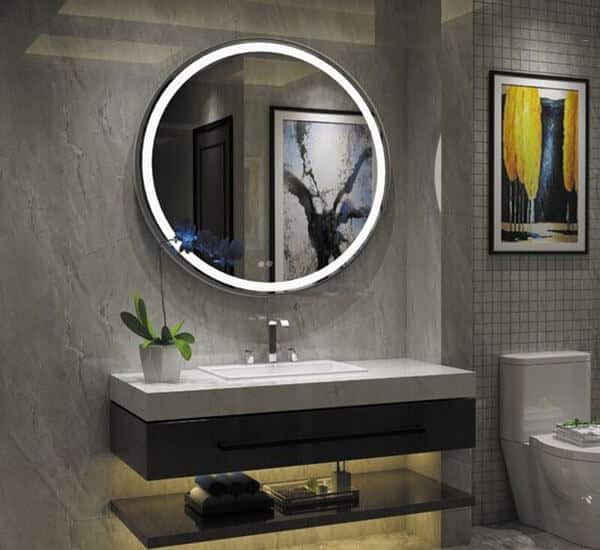
When choosing the size of your bathroom mirror, it is important to consider the following factors.
Vanity Width Considerations:
- The mirror should ideally be narrower than the vanity. Aim for a mirror that is at least 2 to 4 inches less in width than the vanity, ensuring it fits comfortably within the available wall space.
Height Recommendations:
- For the mirror’s height, you want to allow for adequate clearance. A good rule of thumb is to position your mirror at least 4 to 6 inches below the ceiling or above any backsplash, maintaining proportion with the wall space.
Specific Size Guidance:
- For Smaller Bathrooms: If you’re working with a limited area, consider a mirror that covers a substantial portion of the space above your vanity but doesn’t dominate the room.
- For Larger Spaces: Oversized mirrors should still respect the confines of the vanity and wall space.
General Size Ranges:
- Small Bathrooms (under 50 sq ft): Opt for mirrors that are 24-30 inches wide.
- Medium Bathrooms (50-100 sq ft): A width range of 30-42 inches can be appropriate.
- Large Bathrooms (over 100 sq ft): Mirrors can range from 42-60 inches wide.
To ensure you make a confident decision, measure your wall and vanity area accurately.
Read also – Bathroom Mirror Sizes: Choosing the Right Dimensions for Your Space
What Are the Types of Bathroom Mirrors?
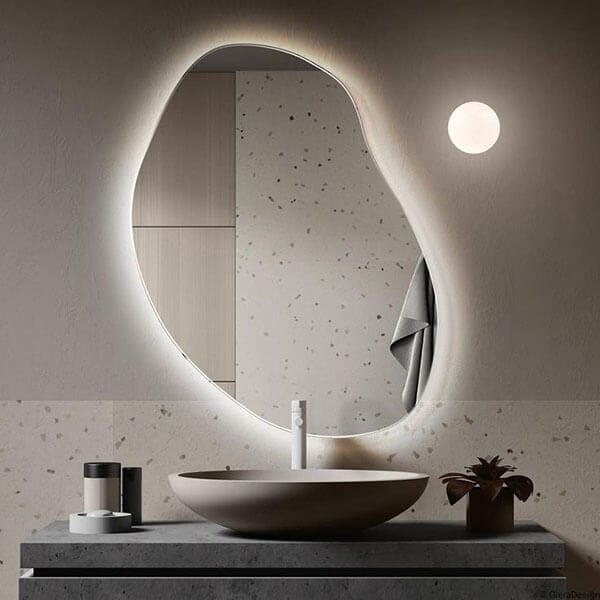
The emergence of LED lighting has revolutionized the design and functionality of bathroom mirrors, and there are now many types to choose from.
Standard Bathroom Wall Mirrors: These are mirrors mounted directly on a wall and come in both framed and frameless varieties. When installing, consider the mirror’s size and weight, which will affect the type of wall fixtures you’ll need.
Pivot Mirrors: A pivot mirror is attached to the wall with a flexible mount. You can adjust the angle for better lighting and a better view, perfect for grooming tasks.
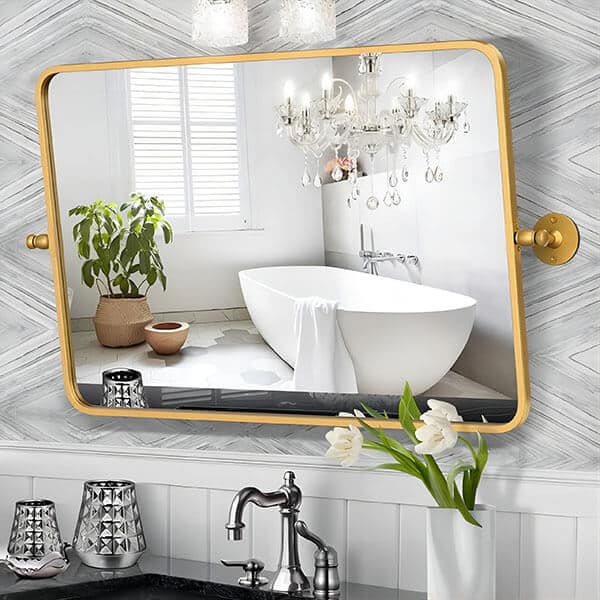
Full-Length Mirrors: You can mount these mirrors horizontally above dual vanities or vertically to get a complete view of your outfit. Their presence can create the illusion of more space and amplify light in the room.
Cabinet Mirrors and Medicine Cabinets: These multipurpose units combine storage with reflection. They can have built-in lighting or not and have additional features like Bluetooth connectivity and shaving sockets.
Illuminated Mirrors: These include mirrors integrated with LEDs or other lighting to facilitate tasks like applying makeup.
Anti-fog Bathroom Mirrors: Known as heated demister mirrors, they prevent steam build-up and maintain a clear view even after hot showers.
Ledge Mirrors: Mirrors with shelves or ledges provide space to keep your essentials within reach.
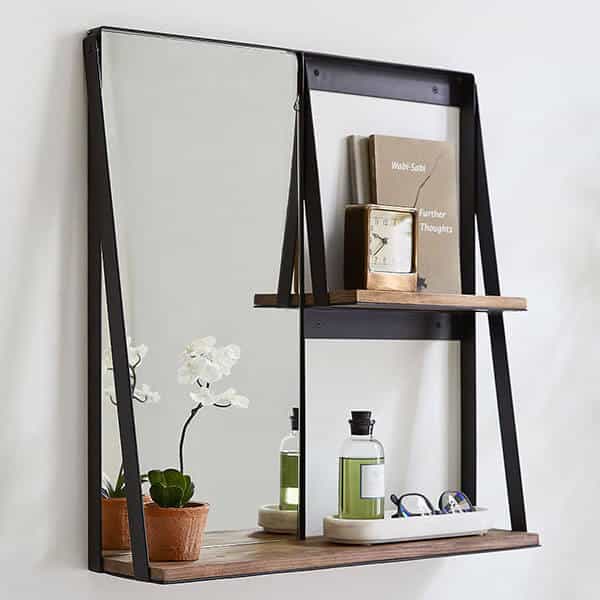
Decorative Mirrors: Smaller, decorative mirrors are aesthetic additions and can be arranged artistically for added visual appeal.
Remember to consider not just the style but also the functionality that fits your routine when selecting a bathroom mirror.
Framed or Frameless?
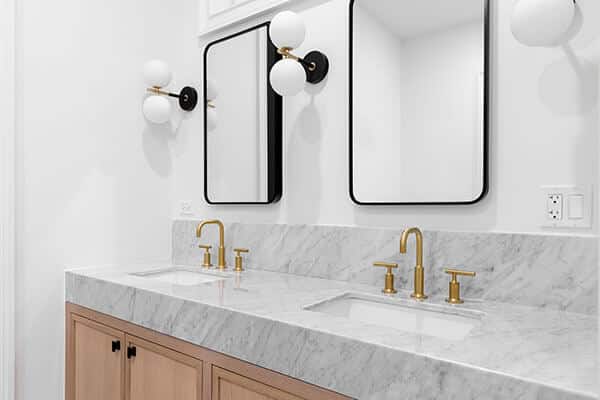
Framed and frameless are both popular options for bathroom decoration. Let’s explore the advantages and disadvantages of each.
Framed Mirrors:
- Style: They offer various design options, adding an element of color and texture to your space.
- Contrast: A frame can create a bold statement or a subtle accent, enhancing the room’s overall aesthetic.
Pros:
- Diversity in design allows for a unique look.
- Frames provide a finished appearance.
Cons:
- Can make a small space feel more confined.
- May have a more traditional look that doesn’t fit with modern decor.
Frameless Mirrors:
- Sleekness: They provide a clean and uninterrupted look.
- Visual Space: Without a frame, these mirrors help to make a room appear larger and more open.
Pros:
- Modern and minimalist appeal fits well with contemporary interiors.
- Less visual clutter can enhance the feeling of spaciousness.
Cons:
- Fewer design variations may lead to a more generic look.
- Requires careful handling due to exposed edges.
When choosing, weigh these factors based on your bathroom’s size, style, and your personal preference for maintenance and aesthetics.
Single or Double Mirrors?
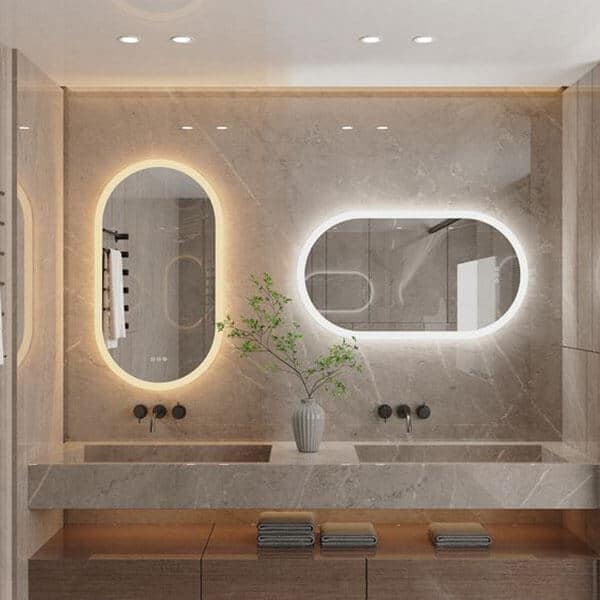
When designing a master bathroom with a large space and two hand wash sinks, should we choose a single large mirror or two separate mirrors?
Single Mirror:
- Space Perception: A single, large mirror spanning the length of the vanity can create the illusion of a larger bathroom space.
- Style Coherence: Opting for one mirror provides a continuous, unbroken surface that reflects light uniformly, offering a cohesive look.
- Installation Simplicity: Mounting one mirror is generally easier, requiring less precision in alignment compared to two separate mirrors.
Table: Comparison of Single and Double Mirrors
| Aspect | Single Mirror | Double Mirrors |
| Space Illusion | Expansive | Individualized |
| Light Reflection | Uniform | Directional |
| Installation | Simpler | More involved |
Double Mirrors:
- Personalization: Double mirrors offer a personal space for each individual using the dual sinks, creating a more tailored vanity area.
- Design Flexibility: You can choose unique frames and sizes for each mirror, allowing for creative expression and style variability.
Functionality: With a mirror dedicated to each sink, two people can comfortably utilize the space simultaneously without interference.
Mirror Glazing Options
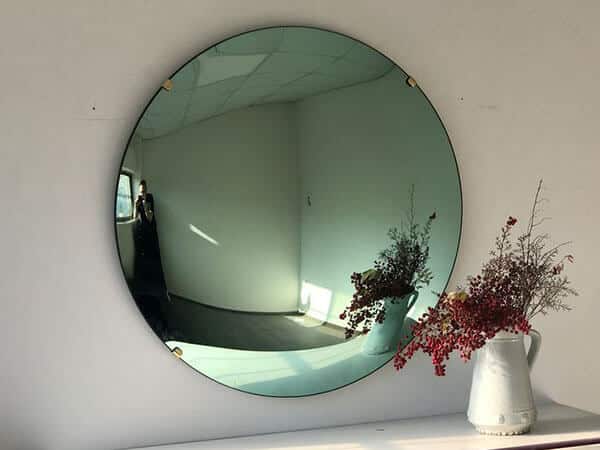
Adding glazing options can enhance the unique style of your design. Here’s a brief overview:
- Silver Coating: This is your standard mirror glaze, providing a clear and accurate reflection. It is the most common finish and is what you typically find in most mirrors.
- Tinted Mirrors: Tinted mirrors have an additional layer that adds a hint of color, which can either be remarkable or warm the reflection. Standard tints include gray, bronze, and gold. These mirrors don’t alter the reflection’s accuracy but can change the room’s ambiance. For example:
- Gray Tints can give a sleek, modern feel.
- Bronze Tints can infuse warmth, making the space cozier.
- Gold Tints add an element of luxury and depth.
- Antique Mirrors: These mirrors are treated to have a vintage or aged look with spots or “imperfections” in the reflective silver layer. They provide a classic and sophisticated charm. The antique effect can range from slight to heavy, giving you versatility in design.
However, It’s important to note that these glazing options are purely aesthetic and don’t interfere with the mirror’s primary function. Choose the one that aligns with your bathroom’s style and your personal preference.
Mirror Functionality
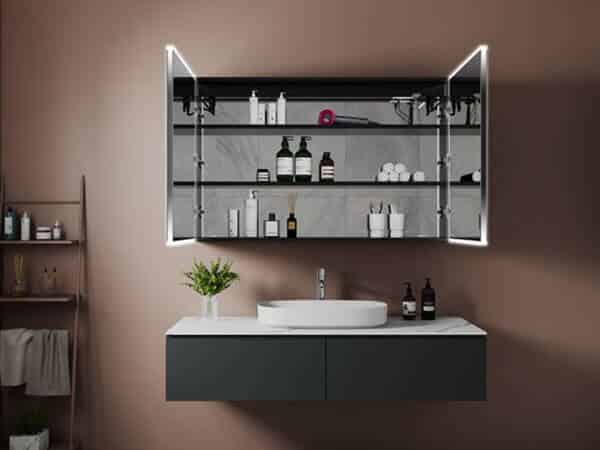
LED lighting technology can enable modern bathroom mirrors to have advanced features. Let’s talk a look at them one by one.
Back Light: A backlight in a bathroom mirror provides a soft glow around the perimeter of the mirror. This can create a mood-enhancing ambiance and also help to illuminate the bathroom gently without the need for harsh overhead lights. By the way these backlights can also be RGB color.
Front Light: Front lights on a bathroom mirror are designed to provide clear illumination for tasks such as shaving, applying makeup, or any other grooming activity that requires good lighting. These lights are typically positioned at the top or around the mirror to minimize shadows on the face.
High CRI 90 LED Light Source for Makeup: The Color Rendering Index (CRI) is a measure of how accurately a light source displays colors as compared to natural light. A high CRI, such as 90 or above, indicates that the light source will make colors look clear, vivid, and true to their natural appearance.
Adjustable Brightness: This feature allows you to change the intensity of the light emitted from the mirror. Adjustable brightness is useful for creating the right lighting for different times of the day or for specific tasks that require more or less light.
Adjustable Color Temperature: Color temperature can be adjusted from warm to cool light. Warm light is typically around 2700K and gives off a yellowish hue, which is relaxing and good for evening routines. Cool light, which is around 5000K or higher, is similar to daylight and is better for tasks that require precision, like applying makeup.
RGB LED lighting: RGB stands for Red, Green, and Blue. Mirrors with RGB LED lighting can display a wide range of colors by mixing these three primary colors. This feature allows you to change the color of the light for different moods or aesthetics in the bathroom.
Anti Fog: An anti-fog feature prevents the mirror from steaming up after hot showers or baths. This is often achieved through a heated demister pad that gently warms the mirror’s surface to keep it clear of condensation.
Shaving Socket: Some mirrors come with a built-in shaving socket, which is a convenient power outlet for electric shavers or toothbrushes. This socket is usually integrated into the side or bottom of the mirror frame for easy access.
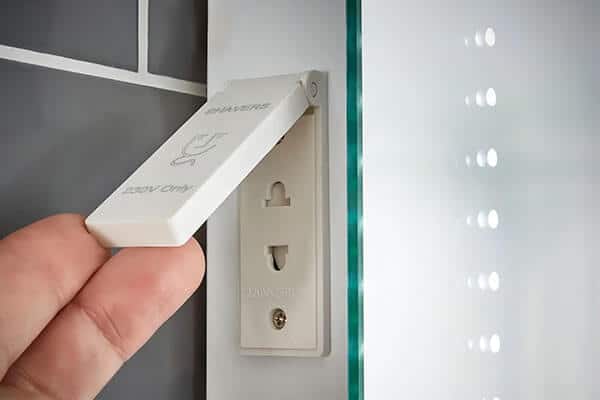
Storage: Bathroom mirrors with storage have shelves or cabinets behind the mirror surface or on the sides. This helps in organizing toiletries, cosmetics, and other small bathroom items, keeping them handy and reducing clutter.
Bluetooth Connection: A mirror with Bluetooth connectivity allows you to pair your smartphone or other devices to stream audio directly to the mirror’s speakers. This can be used for playing music, podcasts, or taking calls hands-free while you’re in the bathroom.
Built-in Speaker: You can listen to audio directly from the mirror itself. This is often part of the Bluetooth connectivity feature, allowing you to play music or other audio from your phone or Bluetooth-enabled device through the mirror’s speakers.
Touch/Wave Switch: Modern bathroom mirrors often come with touch-sensitive controls or wave sensors for hands-free operation. A touch switch allows you to turn the lights on and off with a simple tap on a specific spot on the mirror. A wave switch enables you to activate the lights with a hand gesture in front of a sensor, which is particularly useful when your hands are wet or you want to avoid leaving fingerprints on the mirror.
Night Light: Some LED bathroom mirrors include a night light feature that provides a soft, dim light that can be used during the night. This is especially convenient for providing visibility during late-night bathroom trips without the harshness of full lighting, which can be disruptive to your sleep cycle. The night light is often positioned to specifically illuminate the sink area, making it easier to wash hands or navigate the space in low-light conditions.
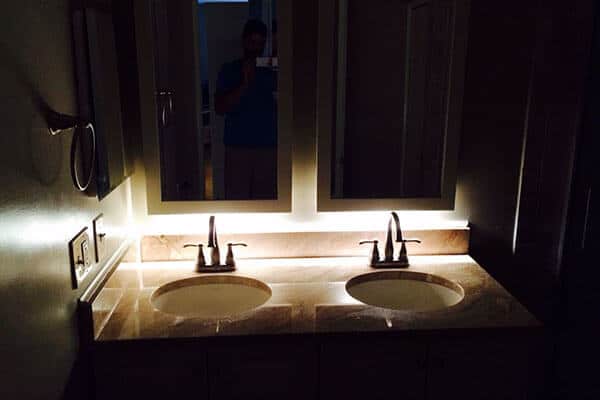
LCD Display: An LCD (Liquid Crystal Display) panel incorporated into a bathroom mirror can show various types of information, such as the time, date, and even weather conditions. This feature transforms the mirror into a multi-functional device, allowing you to stay informed while going about your bathroom routine.
When designing your bathroom, remember that you can customize even more by purchasing items from a bathroom factory.
Where Do You Hang a Bathroom Mirror?
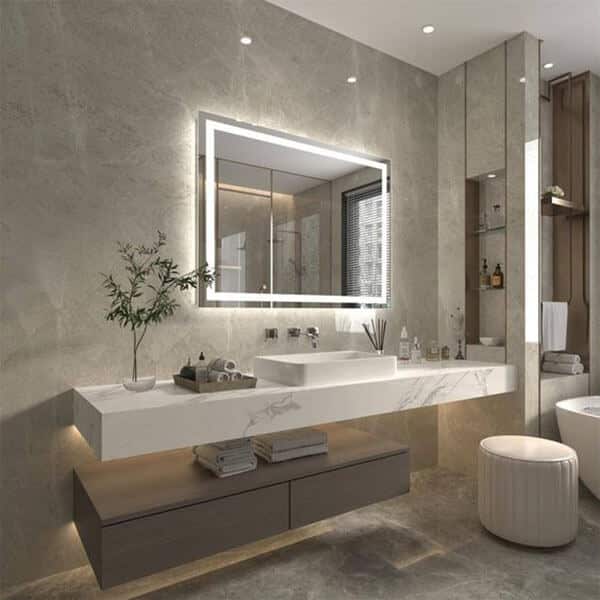
Bathroom mirrors typically hang above the sink, but designers have created unique layouts for different bathroom situations.
Above the Vanity: Your mirror typically finds its home above the bathroom vanity. Center it over the sink, positioning it at eye level to create an optimum view for grooming. Ensure there’s enough spacing between your mirror and the faucet to prevent splashing and water damage.
Reflecting Natural Light: If you’re fortunate enough to have a window in your bathroom, consider placing the mirror opposite the window. This orientation amplifies natural light, making the room feel brighter and more spacious.
Interior Design Enhancements: To add visual interest to your bathroom, hang the mirror adjacent to artwork or other decorative pieces. This strategic placement not merely serves a purpose but also complements your interior design.
Before you mount your mirror, locate the studs in the wall for a secure installation. If the mirror is particularly heavy, anchoring it to a stud is necessary to support its weight. For lighter mirrors or where studs aren’t available, use appropriate wall anchors that match the installation requirements.
Remember, your bathroom mirror is both a tool and an accessory. It’s not just about where it hangs but how it integrates with the overall atmosphere and functionality of the space.
How Much Is a Bathroom Mirror?
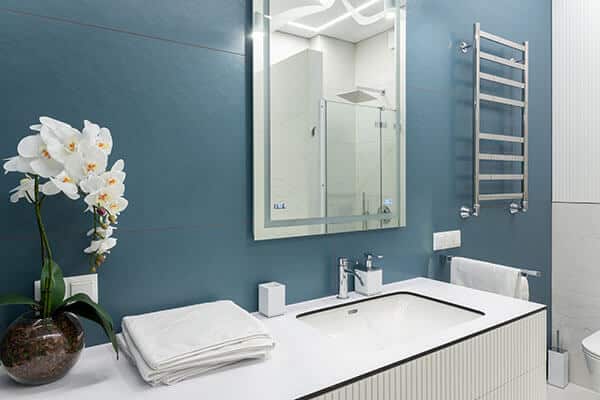
The cost of bathroom mirrors can vary widely, but smaller ones can typically be found for under $75. However, if you’re looking for larger or higher-quality options, the price may exceed $200 or even $300.
Pricing Considerations:
- Size: Smaller mirrors are more affordable, while larger pieces come with a higher price tag.
- Quality & Features: Features like defogging capabilities or flexible mounts can add to the cost.
- Brand: Designer or high-end brands will generally cost more.
Examples of Cost:
| Mirror Type | Price Range | Retailer |
| Basic Rectangular | Under $75 | General retail outlets |
| Round Vanity | Around $99 | Home Depot |
| Oval Mirror | Approximately $188 | Wayfair |
| Square Frameless | About $115 | Wayfair |
When considering the purchase, consider the installation process since some mirrors might require professional help to mount, adding to the overall cost. Pricing details are indicative and can fluctuate depending on sales or retailer changes. Always check the current price before making a decision.
Frequently Asked Questions
Selecting the correct mirror for your bathroom involves considering the environment, size, design trends, functionality, and aesthetics. The following FAQs will address common inquiries to help you make an informed decision.
What are the best types of mirrors for high-moisture bathroom environments?
For bathrooms with high moisture, it’s essential to choose mirrors designed to withstand humidity. Look for mirrors with waterproof backing and a frame made from moisture-resistant materials such as stainless steel or plastic.
Which mirror shapes are recommended for small bathrooms to enhance the perception of space?
In smaller bathrooms, round or oval mirrors can create an illusion of more space. These shapes break up the hard lines of rectangular walls and can help soften the space, making it seem larger.
What are the current design trends for bathroom mirrors?
Contemporary trends include frameless, backlit, and LED mirrors with sleek, clean lines and modern conveniences like built-in lighting. Smart mirrors with features like touch controls and digital displays are also rising.
Could you please clarify how magnifying makeup mirrors work differently in a bathroom?
Magnifying makeup mirrors, such as wall-mounted ones with extendable arms, provide additional functionality by allowing angle adjustments for better visibility and lighting options, which can be particularly advantageous for makeup and hair styling.
